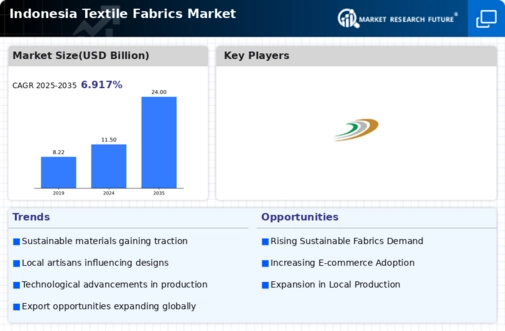Indonesia Textile Fabrics Market Summary
The Indonesia Textile Fabrics market is projected to grow significantly from 11.5 USD Billion in 2024 to 24 USD Billion by 2035.
Key Market Trends & Highlights
Indonesia Textile Fabrics Key Trends and Highlights
- The market is expected to achieve a compound annual growth rate of 6.92 percent from 2025 to 2035.
- By 2035, the market valuation is anticipated to reach 24 USD Billion, indicating robust growth potential.
- In 2024, the market is valued at 11.5 USD Billion, reflecting a strong foundation for future expansion.
- Growing adoption of sustainable practices due to increasing environmental awareness is a major market driver.
Market Size & Forecast
| 2024 Market Size | 11.5 (USD Billion) |
| 2035 Market Size | 24 (USD Billion) |
| CAGR (2025-2035) | 6.92% |
Major Players
P.T. Multi Bintang Indonesia Tbk, P.T. Bumi Fajar Textiles, P.T. Trisula International Tbk, P.T. Primissima Tbk, P.T. Argo Pantes Tbk, P.T. Gunawan Dianjaya Steel, P.T. Sritex, P.T. Pan Brothers Tbk, P.T. Sri Rejeki Isman Tbk, P.T. Asia Pacific Fibers Tbk, P.T. Samudera Indonesia Tbk, P.T. Tifico Fiber Indonesia Tbk, P.T. Indorama Synthetics Tbk, P.T. Gistex Group, Apparel Textile Association












Leave a Comment